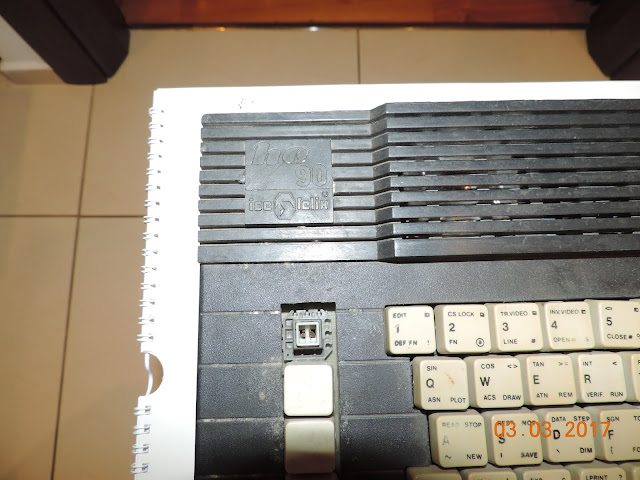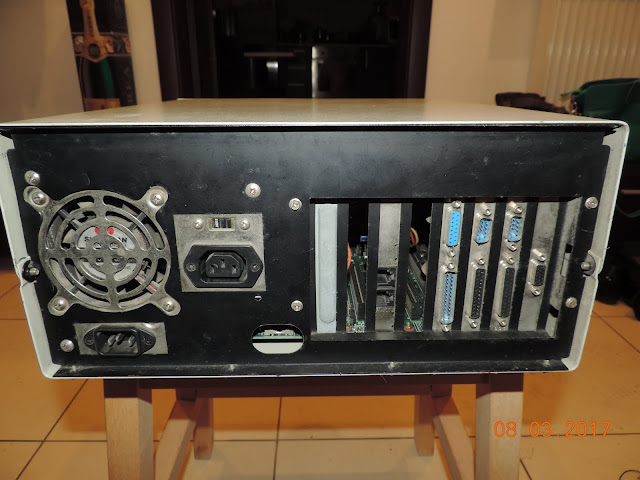
Electronics from hobby to CATV
marți, 4 august 2020
duminică, 26 iulie 2020
PCs & Internet from 12 MHz to 3.5 GHz
Before the PC era (before the Flood) I assembled a HC90 Spectrum compatible starting with a kit from the LEU hotel, the Electronics faculty buiding. I assembled everything OK, but it didn't work.
I asked the guy who sold me the kit to check what happened. It was a PCB connection with poor contact...
This was very good for my brother who was in faculty beginning with 1990. A great tool for programming. For that moment it was enough for his projects.
Working at 3.5 MHz. Internet ? No way !
I also adapted a disc interface for this prehistoric PC:
The counter for Basic programs on cassette. Designed by me, worked with Philips bought by my dad from Italy in 1976
The counter was installed with opened cassette cover
The power supply, adapted on a former car battery charger
The summer of '96 was my first step on Internet, like the first step on the Moon in '69...
My brother had a second-hand 286 @ 6/12 MHz with a color EGA monitor, bought from a colleague.
The system was manufactured in 1990. At the same time he got a PC-NET free internet account from the Faculty of electrical engineering, the same that I graduated.
Having the hobby with satellite & decoders I was interested about the information from Internet.
The 286 was limited to emails, ftpmail and other offline methods to get information.
FTP and WWW were not working on the 286. I succeeded to get what I need using that antiquity.
As I was in a relation with my current wife, I noticed that she had a 386. That PC worked on WWW and she had a dial-up connection, so I exploited that resource.
In 1997 I bought a 486 @ 50/100 MHz with AMD processor.
Later I bought another with a higher speed.
In 2010 I bought a Dell Inspiron with Intel which works great even after 10 years.
In 2018 I switched from PC to an ASUS laptop with i7 @ 3.5 GHz.
30 years of progress, form 12 MHz to 3500 MHz... An incredible speed.
Internet connections from dial-up modems @ 2400, 14400,...56.000 to ADSL and finally GPON.
From the Bell's 2 twisted wires to fiber optics.
I also experimented the internet by satellite. Large amount of data demanded by dial-up and downloaded by the satellite dish via SKYSTAR 2 PCI PC board...
Bought from DIADI TELSAT on April 11, 2001 with 1 year Europe on-line subscription.
I asked the guy who sold me the kit to check what happened. It was a PCB connection with poor contact...
This was very good for my brother who was in faculty beginning with 1990. A great tool for programming. For that moment it was enough for his projects.
Working at 3.5 MHz. Internet ? No way !
I also adapted a disc interface for this prehistoric PC:
The counter for Basic programs on cassette. Designed by me, worked with Philips bought by my dad from Italy in 1976
The counter was installed with opened cassette cover
The power supply, adapted on a former car battery charger
The summer of '96 was my first step on Internet, like the first step on the Moon in '69...
My brother had a second-hand 286 @ 6/12 MHz with a color EGA monitor, bought from a colleague.
The system was manufactured in 1990. At the same time he got a PC-NET free internet account from the Faculty of electrical engineering, the same that I graduated.
Having the hobby with satellite & decoders I was interested about the information from Internet.
The 286 was limited to emails, ftpmail and other offline methods to get information.
FTP and WWW were not working on the 286. I succeeded to get what I need using that antiquity.
As I was in a relation with my current wife, I noticed that she had a 386. That PC worked on WWW and she had a dial-up connection, so I exploited that resource.
In 1997 I bought a 486 @ 50/100 MHz with AMD processor.
Later I bought another with a higher speed.
In 2010 I bought a Dell Inspiron with Intel which works great even after 10 years.
In 2018 I switched from PC to an ASUS laptop with i7 @ 3.5 GHz.
30 years of progress, form 12 MHz to 3500 MHz... An incredible speed.
Internet connections from dial-up modems @ 2400, 14400,...56.000 to ADSL and finally GPON.
From the Bell's 2 twisted wires to fiber optics.
I also experimented the internet by satellite. Large amount of data demanded by dial-up and downloaded by the satellite dish via SKYSTAR 2 PCI PC board...
Bought from DIADI TELSAT on April 11, 2001 with 1 year Europe on-line subscription.
Satellite TV decoders
Filmnet analogue decoder - circuit from an Italian electronics hobby magazine:
The synchronizing signal was sent on 7,56 MHz.
The circuit down is in fact a sound circuit.
The LED shows the decoding status.
Filmnet switched to D2-MAC Eurocrypt
Original Filmnet decoder
The EEPROM could be reprogrammed to allow the use of a remote control.
PACE D2-MAC Eurocrypt decoder:
Videocrypt 1 decoder. Somebody gave me this in autumn 1992.
When I went to Budapest I bought an original VC1 card.
Later I replaced the VC1 circuit inside with Videocrypt 2 in order to receive Discovery for Romania.
Decoder for Premiere Germany. It never worked...
In 1996 I started my Internet adventure, first with a 286 @ 6/12 MHz (!!!) & EGA color monitor.
Using ftpmail I got information how to play with PC emulators...
The synchronizing signal was sent on 7,56 MHz.
The circuit down is in fact a sound circuit.
The LED shows the decoding status.
Filmnet switched to D2-MAC Eurocrypt
Original Filmnet decoder
The EEPROM could be reprogrammed to allow the use of a remote control.
PACE D2-MAC Eurocrypt decoder:
Videocrypt 1 decoder. Somebody gave me this in autumn 1992.
When I went to Budapest I bought an original VC1 card.
Later I replaced the VC1 circuit inside with Videocrypt 2 in order to receive Discovery for Romania.
Decoder for Premiere Germany. It never worked...
In 1996 I started my Internet adventure, first with a 286 @ 6/12 MHz (!!!) & EGA color monitor.
Using ftpmail I got information how to play with PC emulators...
vineri, 24 iulie 2020
Organ of lights & audio amplifier 1983
When I was 16 this was a 'must have' for a party.
The tape recorder, an amplifier, the organ of lights and a ball with mirror squares.
This was the simplest circuit diagram for an organ:
at the audio input it has a transformer for wire broadcasting.
In the high school we assembled wire broadcasting speakers. These had 100 Ohm coil potentiometers, transformers and loudspeakers.
The transformer was good for galvanic separation.
I also put a neon bulb to identify the phase, first time w/o serial resistor. When I checked it I get an electric shock, of course. I added the serial resistor...
As audio amplifier I used the kit sold at Bucharest 'Silicon valley' - Academiei street
This circuit was OK and I remember that Horia Tanase, now professor at the University of Athens, Georgia, asked me to assemble 4 amplifiers in a briefcase in order to be easy to transport the amplifier unit to the parties where he was invited...
We tested the sound in my father's garage with electronic music.
The tape recorder, an amplifier, the organ of lights and a ball with mirror squares.
This was the simplest circuit diagram for an organ:
at the audio input it has a transformer for wire broadcasting.
In the high school we assembled wire broadcasting speakers. These had 100 Ohm coil potentiometers, transformers and loudspeakers.
The transformer was good for galvanic separation.
I also put a neon bulb to identify the phase, first time w/o serial resistor. When I checked it I get an electric shock, of course. I added the serial resistor...
As audio amplifier I used the kit sold at Bucharest 'Silicon valley' - Academiei street
This circuit was OK and I remember that Horia Tanase, now professor at the University of Athens, Georgia, asked me to assemble 4 amplifiers in a briefcase in order to be easy to transport the amplifier unit to the parties where he was invited...
We tested the sound in my father's garage with electronic music.
Kashtan vs. Rostov
My grandmother bought me a Kashtan tape recorder as present when I was admitted at the faculty of electrical engineering, summer 1985. As I was in the army in autumn, my parents bought it from our neighbor's shop. Mr. Manuta (i.e. 'Little hand') was working there and usually import appliances were harder to find. Mr. Manuta (Minuta) was living at Spatar Milescu 17 and he was Aromanian.
Aromanians were working in many commercial places like general technical merchandise stores.
My friend from the same street, number 16, another Aromanian, had a Rostov tape recorder. Rostov was better, with 3 motors, no transmission belt, touch type electric-mechanical orders for play, wind, rewind, stop, record. Glass-ferrite heads. This was my dream...
Here is a comparison between them:
I had the Kashtan with included loudspeakers and power reduction. There was also a model with separate speakers and price almost like the price of Rostov.
I bought 2 wooden acoustic enclosures, 2 medium-bass loudspeakers and 2 RFT tweeters from DIODA store for electronics.
I manufactured the filters according to the indications from the Electronics agenda:
I used 1 uF capacitors from the board of disk telephones.
In May 2020 I bought a Rostov with all seals on their positions.
I gave it to a friend to replace all the electrolytic capacitors.
He has an oscilloscope and it is better for adjustments.
I didn't give up as electronics, but this is my hobby and his qualification.
He is electronics engineer, I am electronics as my high school diploma states and electrical engineer as my faculty diploma states. However, he has more specialized measuring devices than me.
I am waiting for the result of the Rostov's refurbishing.
Grundig TK140 bought in 1969, 3 tubes, still working:
KASHTAN 1985
ROSTOV 105 - 1987, all seals on their positions...
Aromanians were working in many commercial places like general technical merchandise stores.
My friend from the same street, number 16, another Aromanian, had a Rostov tape recorder. Rostov was better, with 3 motors, no transmission belt, touch type electric-mechanical orders for play, wind, rewind, stop, record. Glass-ferrite heads. This was my dream...
Here is a comparison between them:
I had the Kashtan with included loudspeakers and power reduction. There was also a model with separate speakers and price almost like the price of Rostov.
I bought 2 wooden acoustic enclosures, 2 medium-bass loudspeakers and 2 RFT tweeters from DIODA store for electronics.
I manufactured the filters according to the indications from the Electronics agenda:
I used 1 uF capacitors from the board of disk telephones.
In May 2020 I bought a Rostov with all seals on their positions.
I gave it to a friend to replace all the electrolytic capacitors.
He has an oscilloscope and it is better for adjustments.
I didn't give up as electronics, but this is my hobby and his qualification.
He is electronics engineer, I am electronics as my high school diploma states and electrical engineer as my faculty diploma states. However, he has more specialized measuring devices than me.
I am waiting for the result of the Rostov's refurbishing.
Grundig TK140 bought in 1969, 3 tubes, still working:
KASHTAN 1985
ROSTOV 105 - 1987, all seals on their positions...
Abonați-vă la:
Comentarii (Atom)








































































